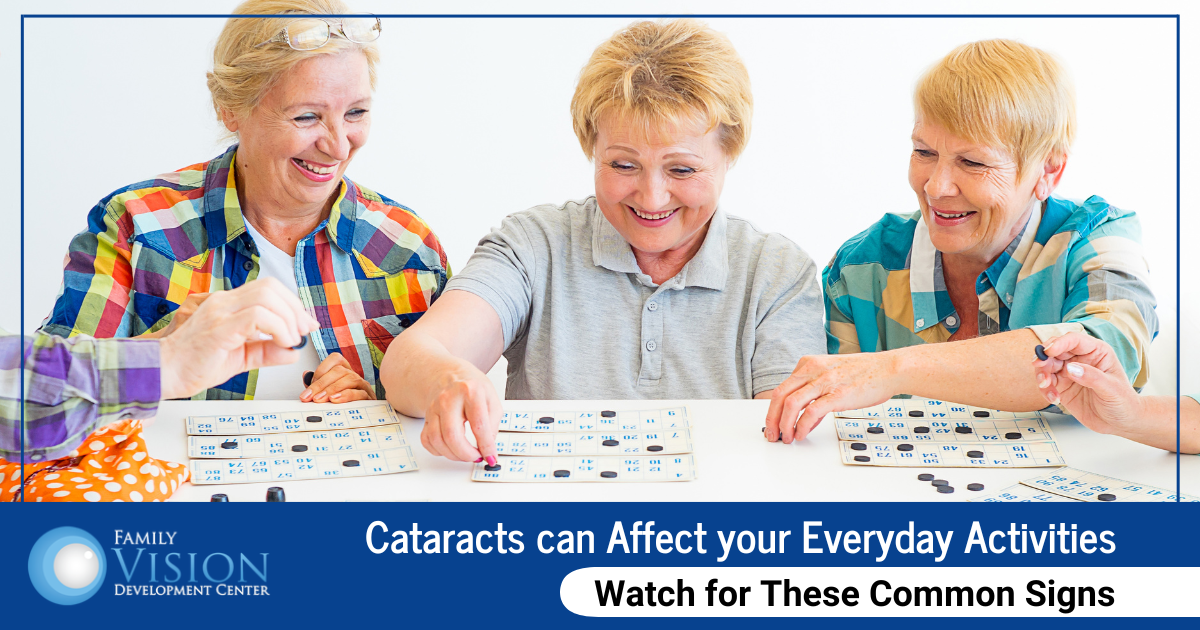Cataracts are a very common, age-related condition. In fact, they affect approximately half of all Americans by age 80. As you age, the lens of your eye can harden and get denser and tissues can break down. As the tissues clump together, a clouding of the lens occurs. This clouding of the eyes is known as cataracts.
If left untreated, they can lead to severe vision loss or even blindness. Fortunately, they tend to develop slowly. This allows time to recognize the symptoms and seek treatment before too much damage has been done. Watch out for the following warning signs, as they can all indicate the presence or progression of cataracts.
Early symptoms of cataracts
- Blurry or fuzzy vision
- Difficulty seeing at night or in dim light
- Seeing halos around lights
- Light sensitivity that doesn’t clear up quickly
- Double vision
- Eyeglass prescriptions that change frequently
- Appearance of a brown or yellow tint in your vision
- Poor depth perception
- Frequent eye strain
- Eye pain
Vision exams are essential to diagnose cataracts
The earlier cataracts are detected, the better the chance for effective management. Often times, people delay an eye exam, assuming their changes in vision are simply a natural result of aging. Unfortunately, this can lead to a progression of the symptoms of cataracts and a higher chance of surgery being required to treat them.
One important way to ensure that cataracts (and other vision disorders) are diagnosed early is to commit to annual vision exams. During this exam, we will perform the appropriate tests to determine your visual acuity and examine your lens for signs of cataracts. Seeing us regularly allows us to note any changes since your last visit and make recommendations for treatment or management as soon as these variations are detected.
Treatment of cataracts
While surgery is the only true form of treatment to eliminate cataracts, there are less-invasive ways to minimize the effects. For example, you can make changes at home to make daily life easier. Increasing the lighting in the house, wearing anti-glare sunglasses, or using a magnifier for reading can all help. In fact, there are many resources available for living with low vision. Implementing easy adjustments in your house, like keeping clutter to a minimum to avoid tripping or using clocks with large numbers can help you live with any new vision loss. And of course, another solution is to get your prescription glasses adjusted to accommodate changing vision due to cataracts.
At Family Vision Development Center, we will monitor your vision, advise on the best options to manage your symptoms, or suggest surgery to remove the cataracts when appropriate. Additionally, we can ensure that you have the most accurate and up-to-date prescription for your eyeglasses. During your visits, we will make sure you have a cataract treatment plan in place and will explain all of your options, including the possibility of surgery if your cataracts start to interfere too much with your quality of life.
Contact our Aurora office at 630-862-2020 to learn more or to schedule your appointment.
Family Vision Development Center is a full-service vision center offering innovative vision therapy services, post-concussive vision rehabilitation, comprehensive vision exams for eyeglasses and contact lenses, management of ocular diseases including glaucoma, diabetes, macular degeneration and cataracts, and a state-of-the-art optical center offering the latest designs in eyewear. We are dedicated to keeping our patients comfortable and well-informed and we will explain every exam and procedure and answer all of your questions. We accept both scheduled and emergency appointments, and offer convenient financing and insurance options to ensure that high-quality vision care is available and affordable to all of our patients.

